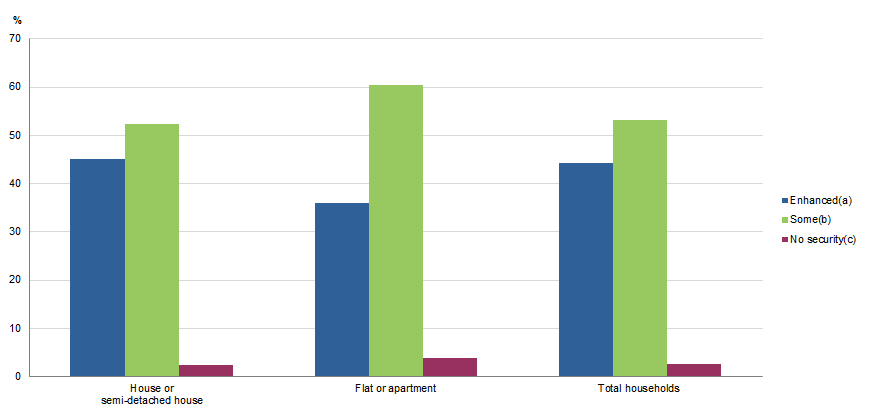LEVEL OF HOME SECURITY (Table 31)
The following section discusses the level of home security in Australian households, it includes an overview of characteristics of households who have enhanced home security and those with some home security.
HOUSEHOLDS, Level of security, by dwelling type, 2017–18

Footnote(s): (a). Enhanced security includes households with at least one window lock and at least one deadlock AND at least one other security measure. (b) Some security includes households with ‘basic security’ or ‘some but less than basic security’, meaning the household has at least one window lock and at least one deadlock OR at least one other security measure. (c) No security includes households with none of the selected security measures installed.
Australian Bureau of Statistics
© Commonwealth of Australia 2019.
ENHANCED SECURITY
More than two in five Australian households (44% or 4.1 million) were classified as having enhanced security. These households had at least one window lock and at least one deadlock AND at least one other security measure.
The following households were more likely to have enhanced security:
- houses or semi-detached houses (45%) compared to flats or apartments (36%)
- households located in capital cities (51%) compared to those in the balance of the state/territory (32%)
- households in the highest quintile of equivalised weekly household income (53%) compared to households in the lowest quintile (37%)
- households in the highest quintile of the Index of Relative Socio-Economic Advantage and Disadvantage (55%) compared to households in the lowest quintile (36%).Endnote 1
SOME SECURITY
More than half of Australian households (53% or 5.0 million) were classified as having some security. These households had ‘basic security’ or ‘some but less than basic security’ meaning the household had at least one window lock and at least one deadlock OR at least one other security measure.
The following households were more likely to have some security:
- flats or apartments (60%) compared to houses or semi-detached houses (52%)
- households located outside of capital cities (65%) compared to those in capital cities (47%)
- households in the lowest quintile of equivalised weekly household income (59%) compared to households in the highest quintile (46%)
- households in the lowest quintile of the Index of Relative Socio-Economic Advantage and Disadvantage (61%) compared to households in the highest quintile (43%).Endnote 1
ENDNOTES
Endnote 1 The Index of Relative Socio-Economic Advantage and Disadvantage ranks areas on a continuum from most disadvantaged to most advantaged. Lower quintiles indicate greater levels of disadvantage and a lack of advantage in general compared to higher quintiles. For further information, see Explanatory Notes.
 Print Page
Print Page
 Print All
Print All
 Quality Declaration
Quality Declaration